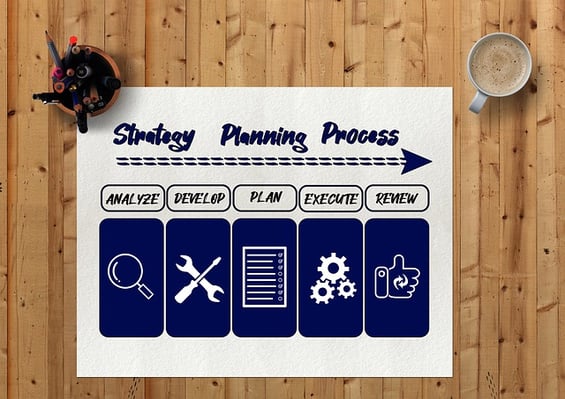Strategy is a plan of action or policy designed to achieve a particular goal or set of goals. It is the means by which an organization hopes to improve its competitive position and achieve long-term success. Strategy can be formulated at any level in an organization, from the top management team down to individual business units or product lines. However, it is most effective when it is developed and implemented as a coordinated effort across all levels of the company.

A big element of organizational strategy includes organizational design. This is the process of creating or modifying an organization's structure to align it with its business goals. Organizational design can involve changes to an organization's hierarchy, job descriptions, reporting relationships, or even its physical footprint.
It's that last point - physical footprint - that we're going to focus on in this article. In particular, we'll be looking at specific organizational design strategies that are very relevant in the current global business landscape: remote, virtual, and international organizations. We'll explore the advantages and disadvantages of each approach, and provide some real-world examples to illustrate our points.
What is a remote organization?
The definition of a remote organization has shifted somewhat in recent years. In the past, a remote organization was typically one where employees were spread out across different geographical office locations. Typically, a company with a remote organizational strategy may have had a large head office in one city, then remote (or branch) offices in many other cities, states or (if the company had decided to go international, see further below) even countries.
These days, however, a remote organization can just as easily refer to a company where some employees work in an office, some from home, and others may even have the flexibility to do both at their convenience.
 During the pandemic, many organizations adapted and considered themselves remote orgs as workers were forced to work from home.
During the pandemic, many organizations adapted and considered themselves remote orgs as workers were forced to work from home.
Remote-first Vs remote-friendly: What's the difference?
Many emerging companies, particularly in the technology space, tend to classify themselves either as a "remote-first" or a "remote-friendly" company. So, what's the difference?
- Remote-first: Organizations often refer to themselves as "remote-first" when working from home is the default option for all employees. Remote-first companies still often have a head-office and sometimes even remote offices, but the expectation of employees going into the office is only considered necessary in specific circumstances (e.g., team meetings, customer presentations, etc.) Therefore, these companies often have small offices that rarely have permanent workspaces dedicated to all employees.
- Remote-friendly: Organizations often refer to themselves as "remote-friendly" when working from home is an option for all employees, but there is still a preference or expectation to come to the office frequently, especially for employees who live within a reasonable commute time. Most of the time, employees will have a dedicated workspace at the office but have the flexibility to work from home as required.
 Companies with remote employees have adopted technology to help them continue to connect and collaborate.
Companies with remote employees have adopted technology to help them continue to connect and collaborate.
Over the last decade, there has been a notable shift in the number of companies adopting either a remote-first or remote-friendly organizational strategy. A big reason for this is the rise of collaborative technology tools, such as Slack, Zoom, and Google Drive, which have made it easier for employees to stay connected and productive when working from different locations. It's also often those very tech companies who outwardly promote their remote-friendly or remote-first workplaces.
Check out this comprehensive guide to some great tips, tricks and tools for remote organizations.
The birth of virtual organizations
The rise of globalization combined with the growth of the Internet and online systems has led to new ways of organizing and structuring businesses. Companies are now able to carry on pretty much as they always have, but without having to house any of their personnel under a company-owned roof.
And so, virtual organizations were born. Virtual organizations are companies that have employees located all around the world, connected through online apps and systems. Automattic, the company behind WordPress.com, is a good example of a virtual organization - they have over 1,800 staff located in nearly 100 countries, and almost all of them work from a premise other than an Automattic office. Other than a simple head office in San Francisco, the company has grown without physical offices.
A company with an organizational strategy that focuses on cost efficiency may favour a virtual organization structure. Another strategic imperative could be around building a team from a broader pool of diversity, which virtual organization structures also gain from. But virtual organizations don't come without drawbacks. They can be challenging to lead and manage effectively.
Read more about virtual organizations and the pros and cons.
About international organizations
When a company realises that country-specific market and cultural differences make a "one size fits all" approach to organizational strategy unworkable, they may start to explore the idea of an international organization.
An international organization is one that has a presence in multiple countries, with each country office being tasked with localizing the company's products or services to fit the needs of that market.
Many multinational companies, such as Coca Cola, IBM, and Nestle, have organizational structures that can be classified as international. These companies have a centralized head office, but also many smaller country offices that operate with a great deal of autonomy.
 Coca-Cola is a great example of an international organization. This photo shows their product being delivered in Vietnam.
Coca-Cola is a great example of an international organization. This photo shows their product being delivered in Vietnam.
Organizing an international company requires careful consideration of the best way to structure the business in order to manage these challenges effectively. There are a few different ways to do this, and each has its own advantages and disadvantages.
For example, functional and product organizational structures are two options for international companies, which we discuss in more detail in this article.
Setting up a local country office doesn't always mean being successful, as the global fast food chain Mcdonald's has discovered. McDonald's found difficulty in some countries adapting its standardized menu to local tastes. In one particular country, it ended up closing all 11 outlets it had opened only a decade or so earlier.
 The famous "golden arches" can be spotted in many countries across the globe. But setting up internationally comes with challenges.
The famous "golden arches" can be spotted in many countries across the globe. But setting up internationally comes with challenges.
So, what's the verdict? Should you be a virtual organization, remote organization or international company? The answer is... it depends! You need to take into account your specific goals and needs in order to make the best decision for your business. But hopefully, this article has given you some food for thought and helped you start thinking about how to structure your business in a way that will enable you to succeed.
Few companies would make a strategic decision around their organizational design without some level of planning.
Functionly provides a fast way to import your people and view your organizational structure across an unlimited number of scenarios.
So you can map out and visualise a remote, virtual and international structure.
Sign up now for a free trial and let us show you how creating org charts for your structure can help you manage and grow your business, virtually, remotely and internationally!





